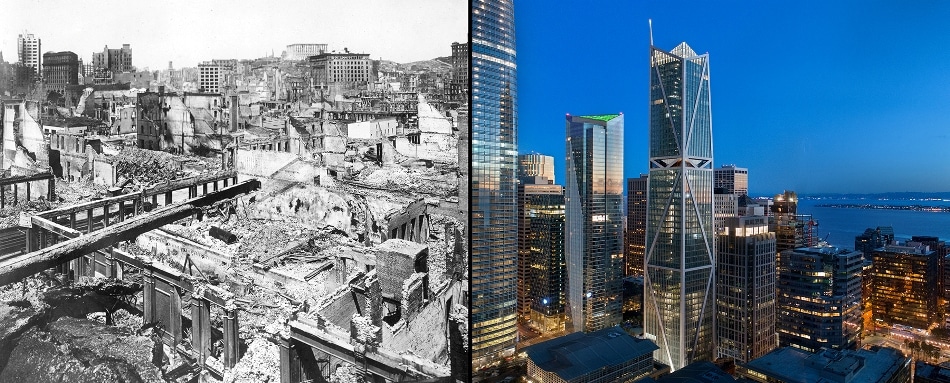Aug 23 2018
After a tornado, earthquake, hurricane, or other natural disasters, it is considered a win if nobody gets injured and buildings remain standing. But an even greater victory is feasible: keeping those structures in operation. This outcome could become more possible with better standards and codes for the construction of commercial and residential buildings, according to a new report recently provided to the U.S. Congress by the National Institute of Standards and Technology (NIST).
 The devastation (left image) following the 1906 earthquake that dramatically impacted the economic and social growth of San Francisco compared with the "West Coast's most resilient skyscraper," the 181 Fremont tower (right image, center), designed to withstand a 475-year seismic event with minimal disruption. Ironically, the tower stands one block from the corner seen in the 1906 photo. (Image credit: (left image) California State Library, (right image) Jay Paul Company)
The devastation (left image) following the 1906 earthquake that dramatically impacted the economic and social growth of San Francisco compared with the "West Coast's most resilient skyscraper," the 181 Fremont tower (right image, center), designed to withstand a 475-year seismic event with minimal disruption. Ironically, the tower stands one block from the corner seen in the 1906 photo. (Image credit: (left image) California State Library, (right image) Jay Paul Company)
Current standards and codes focus on preserving lives by reducing the likelihood of significant building damage or structural collapse from hazards. But they generally don’t address the additional need to preserve quality of life by keeping buildings habitable and functioning as normally as possible, what we call ‘immediate occupancy.’ The goal of our report is to put the nation on track to achieve this performance outcome.
Steven McCabe, Director of the NIST-led, multi-agency National Earthquake Hazards Reduction Program (NEHRP) and one of the authors of the new publication
The impact of a natural disaster on a community is typically most obvious in the lives lost and physical destruction, but the associated social disruptions, economic shock, and reduced quality of life can frequently be overwhelming as well. “Cities and towns can be rebuilt, but lifestyles are damaged, sometimes permanently, if businesses, schools, utilities, transportation and other essential operations are out of service for an extended period,” said Therese McAllister, manager of NIST’s Community Resilience Program and another report author.
The notorious 1906 San Francisco earthquake provides a vivid example of that impact. In the half-century following the 1840s Gold Rush in California, San Francisco was the fastest expanding metropolitan area in the state. That was totally marred on April 18th, 1906, when the quake and resulting fires wrecked 80% of the city, killed nearly 3,000 residents and left almost 300,000 people—three-fourths of the population—homeless, out of work, and without vital services. Though San Francisco would rebuild rapidly, the disaster diverted industry, trade, and people south to Los Angeles, which then displaced the “City by the Bay” as the largest, most significant urban center in the western United States.
Even with up-to-date building codes and standards in order, there is still room for development, as proven by the huge damage from the May 2011 tornado in Joplin, Missouri, and the three massive 2017 hurricanes striking Florida, Texas, and Puerto Rico.
“Immediate occupancy performance measures would help avoid catastrophes because they could build up a community’s resiliency against natural hazards so that people still can live at home, still can go to work and still can have the supporting infrastructure providing them services such as water and electricity,” McCabe said.
In 2017, Congress commissioned NIST to establish what it would take to realize instant occupancy performance codes and standards for all buildings in all types of natural disasters, particularly in terms of major research requirements, probable technological applications based on that research and important strategies that could be used to execute any resulting regulations.
The outcome of that effort is the new NIST report, Research Needs to Support Immediate Occupancy Building Performance Objective Following Natural Hazard Events (NIST Special Publication 1224). The publication identifies a large collection of research and implementation activities that target improved performance objectives for commercial and residential buildings.
“The report provides valuable information about steps that could be taken to achieve immediate occupancy in the future,” McAllister said.
The possible research activities described in the report to Congress were developed with the help of a steering committee of renowned experts and stakeholder input gathered during a national workshop organized by NIST in January 2018. The workshop participants identified four main areas that they believe must be taken into consideration when developing plans to realize immediate occupancy performance: building design, economic and social impacts, community needs, and fostering approval, and use of new practices.
For instance, the report mentions that immediate occupancy performance measures must be created, established, and implemented with sensitivity to how they will economically impact business operators, building owners, occupants, and even entire communities. “You have to make sure that the cost of keeping buildings functional after natural hazards remains reasonable enough that everyone will be able to afford them,” McCabe said.
The report also deliberates on crucial challenges facing the effort to make buildings operational in the wake of natural disasters, such as inspiring communities to make the investment, managing how costs and benefits are balanced, and bringing in public support.
Finally, the report concludes by acknowledging that “increasing the performance goals for buildings would not be easily achieved, but the advantages may be substantial” and that making such objectives a reality “would entail a significant shift in practice for development, construction and maintenance or retrofit of buildings.” The report, its authors state, is the main step toward developing an action plan to accomplish immediate occupancy across the country with coordinated and comprehensive research goals and implementation undertakings.
“Our report outlines the steps that could be taken for a big raise of the bar - perhaps the biggest change in building standards and codes in 50 years - but one we believe is possible,” McCabe said.